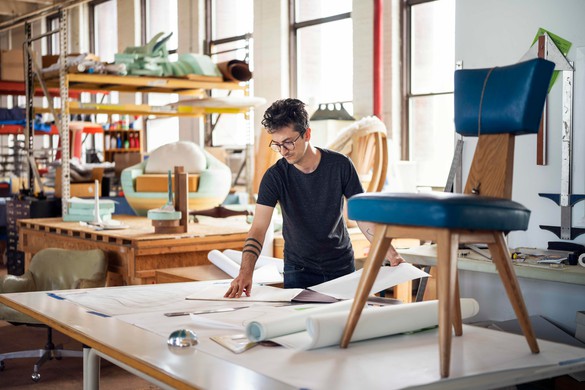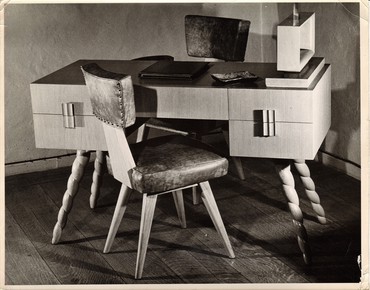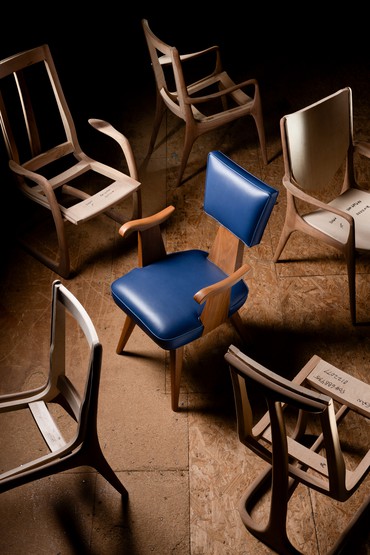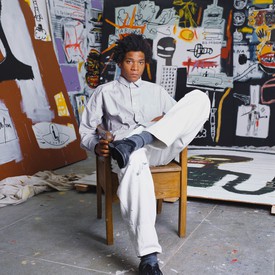
Wyatt Allgeier is a writer and an editor for Gagosian Quarterly. He lives and works in New York City.
Wyatt AllgeierChris, when did you meet Vladimir Kagan?
Chris EitelI met him in 2013, when I was a student at Kendall College of Art and Design studying furniture design. Vladi often recruited designers and interns from Kendall. He was looking for an intern, and I applied. Vladi was in New York, and I was in Grand Rapids, Michigan, so we conducted the interview over Skype. At the end of it, he says: “Chris, I think this is going to be a really fun summer. I’d love for you to come out to Nantucket and work with me.” And then his daughter Vanessa walks into the room and says, “Dad, how’d your intern interview work out?” And he responds: “Oh, great, I hired him. Can you help me figure out how to turn the camera on so I can see what he looks like?”
WAHe didn’t see you at all the whole time?
CEThe whole time [laughs]. Years later, after I was an intern and I was apprenticing with him, he used to always joke about how he hired me sight unseen.
WA So you went to Nantucket?
CEYes, I moved up for the summer, and we worked together. After my internship I had a semester left to get my degree. I went back to school, but we stayed in touch, and he called me up one day and said: “I’ve got some cool projects I’m working on. I’d like to have the same kind of setup we had in Nantucket, so if you would like to come to Palm Beach, where I’m going to be for the winter, then why don’t you come down?”
WAHard to say no.
CEWe did that winter in Palm Beach. In the spring we came back to New York and Nantucket, and we went to visit his sister in Europe that summer. We took our work wherever we went.
WAWhat were you working on during those travels?
CEWe spent a lot of time sketching but also just looking, taking inspiration from our travels. Some of the first projects we worked on together were the Annecy Collection and the Gabriella Chair. Eventually we got to a point where we could only do so much in his home studio and needed to start translating our concepts into models, mockups, and prototypes. That’s really what brought me here to the Clifton studio.
WALet’s talk about the First Chair. It’s a fascinating look into his biography and provides a unique insight into the genesis of where his work would develop.
CEYes. He designed it in 1946–47, so at that time, Kagan’s not really the Kagan we know yet. He’s graduated high school; he’s taking architecture classes at Columbia at night. He’s working for his father’s cabinet-making company as the furniture designer. Over time he gets a few of his own clients, and they start to grow the business, expanding beyond cabinets. He designed his first chair for his parents’ house. That’s where it all begins.
Then, in 1948, Vladi and his father open their first showroom, on East 65th Street. I think Vladi would describe it as a real family affair—his mother and sister also worked there. You can see different versions of the First Chair pop up in historical images from that showroom.
Around 1950, a friend of his, Hugo Dreyfuss, a textile designer, said to him, “Hey Vladi, let’s partner,” and they formed Kagan-Dreyfuss and opened a larger showroom down the street. That’s when Vladi evolves into his sculptural phase. The First Chair and Table have those straight lines, with legs that flare out from the skinny base to hold up the body. You can see references to a baby fawn or a filly. You see similar inspiration—nature, trees, animals—in his later work, just interpreted in a different way.
WADefinitely. Aside from the natural world, what were other sources of inspiration for Kagan?
CEIt could be anything. When we were in Nantucket, we would take his little whaler boat out in the evenings, cruising the harbors to look at all the big yachts. You’d see all types—really classic-looking yachts, newer superyachts—and we would have conversations about the designs.
WAIn fashion houses there’s always this play between the original designer’s legacy and also keeping things new and relevant to the changing of time, the changing of space, the changing of bodies. What does it mean to you to honor Kagan’s legacy while also working to meet the contemporary moment?
CEWith the First Chair, for example, we’ve worked diligently to stay true to the history, while also considering how the lives of our customers have changed since the 1940s. We have access to the Kagan family archive, and developing a familiarity with his original chair was the first stage; I didn’t want to change much of it. If you look at these new versions, we’ve made decisions about scale—the dimensions of a contemporary dining room table require a taller chair—as well as adaptations with the arms of the chair. With this in particular, and with future projects more generally, we’re holding on to the heritage and history of Kagan, but then we have to think through how we tell the story of it, through our textile selections, finishes, etcetera.
WAAnd how long have you been partnering with HOLLY HUNT?
CESince 2016. Vladi knew that he was going to leave a legacy in the design world, and he was always a fan of HOLLY HUNT. He was friends with Holly and had been talking with her about having her brand shepherd his legacy. It’s been a real blessing; the HOLLY HUNT team really supports our initiatives. It’s a very complementary relationship.
WAWhat do you hope to do next? Can you talk about other pieces you want to revisit, or are there unrealized projects of his?
CEWe’ve done a lot of reintroductions that focus on certain time periods or decades, in addition to the Forward Collection, which launched in 2022; those pieces were entirely new designs but still embodied the Kagan ethos and what I learned from him. Looking ahead, I’m working on limited-edition pieces. Also, Vladi was a very prolific sketcher and left us with hundreds of concepts in his archives. I’ve got a lot to play with.
Photos: courtesy Holly Hunt
Vladimir Kagan is exclusively available through design professionals. Please contact HOLLY HUNT for more details.















